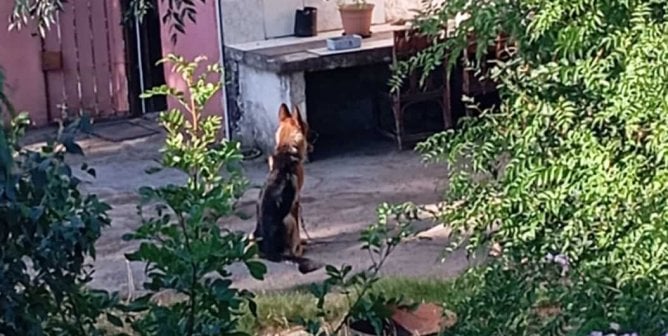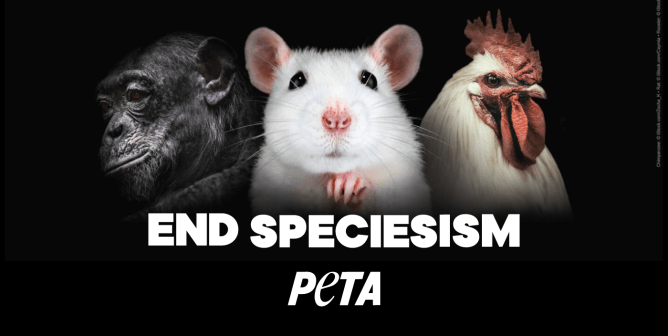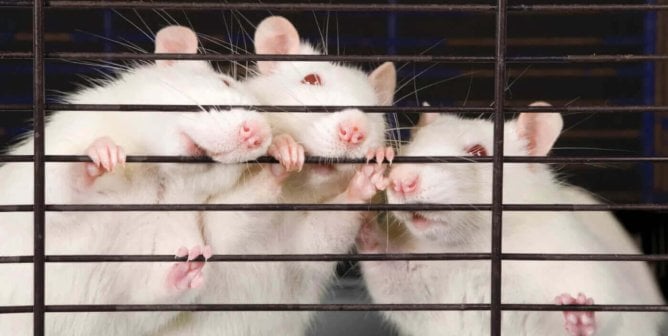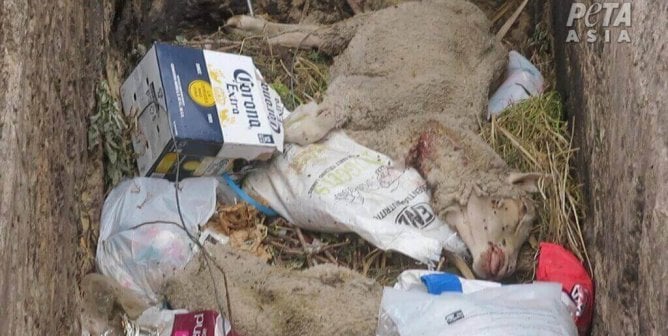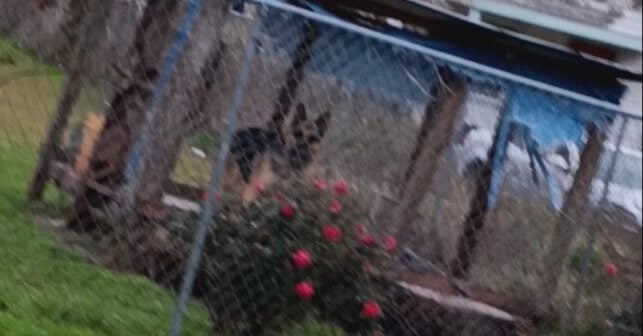Why Some Coconut Products May Not Be Vegan
Coconut milk is a popular choice for those who don’t want to support cruelty to animals by using cow’s milk. However, the process of obtaining coconuts for milk and other products can involve the appalling treatment of primates.
Where Coconut Milk Comes From
There are about 80 varieties of coconut palms, which are distinguished by characteristics such as “dwarf” or “tall.” The palms are grown on plantations and farms as far north as Hawaii and as far south as Madagascar, but the world’s top producers of the fruit are in Southeast Asia.1,2
Coconut water and coconut milk are two different products. Coconut water is found naturally within young, green fruits. Coconut milk is made by grating flesh from a brown, mature coconut, soaking it in water and then straining it to produce a milk-like consistency. Coconut milk has long been a staple of Asian cuisine, and the worldwide trend toward healthier food has led to a boom in sales of alternatives to cow’s milk, with an estimated market value in the billions of dollars.3 Thailand, one of the world’s largest exporters of coconuts, exported $395 million worth of coconut milk in 2019.4
Pig-tailed macaques, Macaca nemestrina, are a highly social species of primate found in the rainforests of Southeast Asia.5 Humans have been kidnapping pig-tailed macaque infants from their homes in nature, raising them, and forcing them to harvest coconuts and other fruit for centuries.6 One psychologist visited Thailand in 1967 to witness how monkeys were used for this purpose and wrote for the journal Science, “The training is based exclusively on punishment and avoidance of punishment.” He reported that monkeys were chained and strangled as part of the process and that “[t]he monkey gradually learns that if he keeps working on the coconut, he will not be unbalanced, choked, or whipped… [A] lesson was always terminated because the trainer was tired, not because the monkey had mastered a step. Food might be given afterwards, but generally not by the trainer, and often after considerable delay.” He remarked on the long hours the animals were forced to harvest coconuts. “What keeps them working for several consecutive hours, particularly when they are in treetops 25 meters above their master?” he asked. “Fear is certainly one factor, since an animal who stops working is whipped.”7
Decades later, nothing has changed on some of these farms.
A study published in PLOS ONE of more than 100 tourist attractions in Thailand found that where monkeys were forced to harvest fruit and/or to put on shows, they were found to be in cages and leashed with “impossible or extremely limited social contact between conspecifics … [an] absence of environmental enrichment, fundamental lack of hygiene, mistreatment by handlers and severe stress or discomfort as a result of show activities or intense interaction with visitors.” The study concluded that “[d]ue to missing accountability and limited regulation, valid concerns exist that the demand for wild animals through tourism is having a negative impact on the conservation of wild species and that the existing captive wild animals are suffering through inadequate husbandry conditions.”8
PETA Asia Investigations
In 2019, PETA Asia investigators visited eight farms where monkeys are forced to pick coconuts as well as several monkey-training facilities and a coconut-picking competition.
Monkeys were seen transported in cramped cages that were barely large enough for them to turn around in, and others were left in locked cages in the back of a pickup truck for extended periods of time, with no shelter from the driving rain. Denied the freedom to move around, socialize with others, or do anything else that would be natural and important to them, these intelligent animals were seen pacing and circling endlessly on the barren, trash-strewn patches of dirt where they were chained.
Investigators documented monkeys tethered by the neck with a metal collar, being forced to climb up and down the palm trees, which were as tall as 80 feet.
One investigator learned that if monkeys try to defend themselves, their canine teeth may be pulled out.
To earn more money with these animals, some trainers also forced them to participate in circus-style shows in which they entertained paying visitors by riding bicycles, shooting basketballs, and performing other demeaning and meaningless tricks.
In response to international criticism following the release of these investigations, the Thai government and companies that make coconut products have claimed that monkeys are no longer used in the making of exported products. A new investigation by PETA Asia, conducted from December 2021 to July 2022, has confirmed that rampant abuse of primates is still going unchecked—and that Thai coconut industry insiders are deliberately hiding monkey labor in their supply chain.9
Alternative Harvesting Methods
Other coconut-growing regions harvest coconuts using humane, more efficient methods, such as tractor-mounted hydraulic elevators, human tree-climbers, rope or platform systems, or ladders or they plant dwarf coconut trees. These methods are all superior to forcing monkeys, who can’t distinguish between ripe and unripe fruit, to gather coconuts.
Where Coconut Water Comes From
Coconut water in Thailand typically comes from coconuts grown on dwarf trees, including the Nam Hom variety, so harvesting them doesn’t require monkey labor.10 But that doesn’t necessarily mean that monkeys won’t be used. PETA has confirmed, however, that Harmless Harvest is among the companies that don’t use monkey labor for coconut water.
What You Can Do
Please, make sure that your coconut products don’t come from any companies that exploit monkeys, including Chaokoh.
Following PETA Asia’s investigation, more than 25,000 stores worldwide—including Food Lion, Walgreens, Duane Reade, Morrisons, Asda, Tegut, and Albert Heijn—will no longer sell Chaokoh products, and the majority will no longer buy any coconut products derived from Thai monkey labor.
Sign our petition urging Chaokoh to obtain its coconuts from farms that don’t use monkeys and stop supporting this cruel industry.
References
1Library of Congress, “Is a Coconut a Fruit, Nut or Seed?” Everyday Mysteries, last accessed 25 July 2020.
2Nithin Coca, “Coconut Farmers in Southeast Asia Struggle As Palm Oil Muscles In on Them,” Mongabay, 30 Mar. 2020.
3Brian Kateman, “Non-Dairy Milk Alternatives Are Experiencing a ‘Holy Cow!’ Moment,” Forbes, 19 Aug. 2019.
4The Associated Press, “Thailand Denies Monkeys Abused to Harvest Coconut Products,” Los Angeles Times, 7 July 2020.
5Wisconsin National Primate Research Center, “Pigtail Macaque, Macaca nemestrina,” Primate Info Net, 21 Nov. 2011.
6Eliza Barclay, “What’s Funny About the Business of Monkeys Picking Coconuts?” NPR, 19 Oct. 2015.
7M. Bertrand, “Training Without Reward: Traditional Training of Pig-Tailed Macaques as Coconut Harvesters,” Science 155(1967): 484-6.
8Jan Schmidt-Burbach et al.,”Asian Elephant (Elephas maximus), Pig-Tailed Macaque (Macaca nemestrina) and Tiger (Panthera tigris) Populations at Tourism Venues in Thailand and Aspects of Their Welfare,” PLOS ONE 10(2015): 9.
9Lisa Fickenscher, “Monkey Slave Labor Is Rampant on Thailand’s Coconut Farms: Report,” New York Post, 22 Nov. 2022.
10Pablito P. Pamplona, Ph.D., “Opportunities in Growing Coconut for Sweet Aromatic Water and Young, Tender Nuts,” Agriculture Monthly, 7 Mar. 2018.

